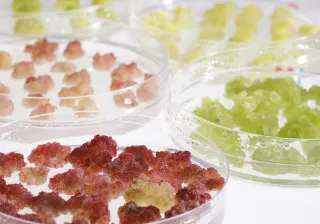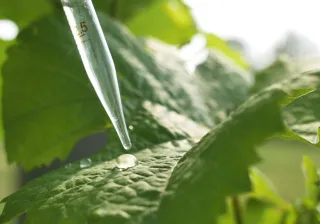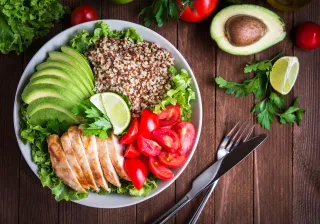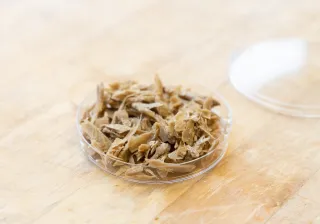Principal Scientist Riitta Puupponen-Pimiä has done her life's work in plant biotechnology, specialising in the health impacts of Nordic berries. Over her career, she has seen how the special characteristics of various berries have grown into a serious business. As a pioneer of berry research, she has been a part of raising our berries to international fame.
– Berries have been used in folk medicine for centuries, and we have clear, scientific evidence of their health benefits. There is now a huge interest towards well-being, nature and health, and Finnish, organic-quality forest berries are an incredible natural resource. I predict that the berry boom will be accelerating, says Riitta Puupponen-Pimiä.
Puupponen-Pimiä was first introduced to VTT as a summer intern in 1981. Studying biotechnology and microbiology, she thought that VTT seemed like an interesting workplace, but couldn't have expected to be retiring from the same company 40 years later.
In the early 1980s, Professor Veli Kauppinen from the Helsinki University of Technology – nowadays a part of Aalto University – established a plant biotechnology group that Puupponen-Pimiä was invited to join immediately. After a few years, the group moved to VTT and Puupponen-Pimiä went along. Once she completed her licentiate thesis and doctoral dissertation in the doctoral programme of the Academy of Finland, she moved to VTT's payroll. This was now 30 years ago.
Riitta Puupponen-Pimiä's career in berry research started at VTT in 1980's.

Modern berry research sparked a flame within
Modern berry research started at VTT approximately 25 years ago. At that time, Puupponen-Pimiä was coming back from maternity leave to a reformed organisation. The plant biotechnology team had become more closely associated with food research. The bioactive compounds of berries, especially polyphenols, had become of global interest. The focus of VTT's berry research had shifted accordingly.
That's when Puupponen-Pimiä found her own scientific passion.
– Polyphenols protect berries from stress conditions. In humans, they act as antioxidants and prevent infections. Arctic conditions stimulate the quantity of these compounds in berries. I wanted to focus on researching the effects that Nordic berries have on people's health, says Puupponen-Pimiä.
From berry researcher to academic messenger
For Finland, berry research was an important topic: our forests are full of berries and they were attracting international interest. This led to a succession of projects funded by Business Finland that investigated the health effects and antimicrobial properties of polyphenols.
In addition to her role as a researcher, Puupponen-Pimiä soon had the opportunity to popularize science and make its results known through training events and articles.
– Polyphenols were a new thing for public, and difficult terms did not make it an easy subject to promote. We have to share information about science in a way that helps people understand the core of the matter.
From cell cultures to bioprocessing and by-products
Puupponen-Pimiä’s research topics have varied from cell culture technology to bioprocessing and utilization of berry by-products. She has also been involved in clinical research in a joint project with the University of Eastern Finland. Each new perspective has given her a better understanding of polyphenols and research work.
– With cell cultures, we can access berries’ entire biosynthetic capacity. In Finland, Lumene is using a cloudberry cell culture developed by the VTT plant biotechnology team, and it has also attracted international interest. Bioprocessing, on the other hand, brings new properties to polyphenols. VTT's food specialists have access to processes and enzymes suitable for bioprocessing, and our infrastructure makes even factory-scale processing possible. This has brought our research work closer to real life.
Producing juices and jams results in waste in the form of press cakes that consist of seeds, and these cakes can be used as berry by-products. Many antimicrobial compounds accumulate on the surface of the seeds, and they can be used to produce extracts to be used as ingredients in food, cosmetics or even pharmaceuticals.
– This opens up new business opportunities alongside classic berry products. Our work in this area has produced so far four patents, she mentions.
For the commercialisation of new business opportunities, Puupponen-Pimiä has investigated in Research to Business projects funded by Business Finland . The projects have taught her to focus on markets, consumers and competitors in addition to research.
The husks of berry seeds have properties worth using in cosmetics to prevent the growth of harmful microbes. VTT has developed a method of recovering active substances from seed husks.

A better world with berries
Puupponen-Pimiä’s eventful journey at VTT culminated with two projects in the iBEX programme. The programme aims to solve major global challenges – such as overcoming infections caused by multi-resistant bacteria with the antimicrobial properties of berries.
– VTT funds the iBEX projects and our management follows them closely. A big investment indicates that we are doing something very meaningful. Our working methods are exceptional and these projects have made clear the enormous power of teamwork. One of our partners has been Helsinki University Central Hospital where we had the opportunity to test berry extracts against MRSA strains that cause serious infections.
The versatile roles Puupponen-Pimiä has had during her career and the skills she has learned in these roles all proved necessary during the iBEX projects.
– Scientific competence is the foundation of everything, but you need much more than that. In the iBEX programme, I got to see the entire scope of the research.
VTT has provided a unique multidisciplinary environment for Puupponen-Pimiä’s berry research. She would like to thank her colleagues for their time working together.
– Research Manager Kirsi-Marja Oksman-Caldentey has played a key role both in the funding negotiations and by encouraging me in my work. My closest colleague, microbiologist Liisa Nohynek, has been doing this work alongside me throughout my whole career.
Expecting a berry boom
Puupponen-Pimiä is interested to see which aspect of berry research will be spearheading the development next. She believes in cell culture technology and the utilisation of industrial by-products.
Puupponen-Pimiä's retirement plans include renovating her family's 100-year-old house in Savo and spending time with her young grandchildren. And maybe picking some berries in the forest.







